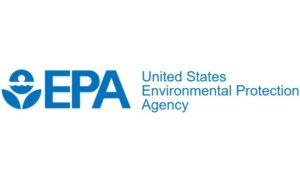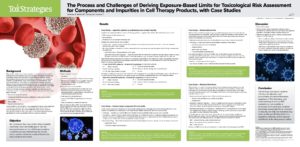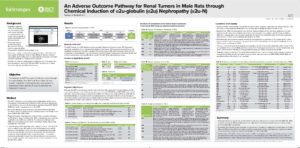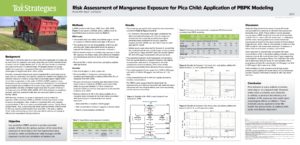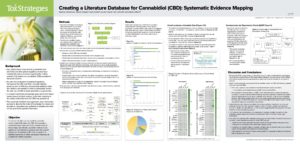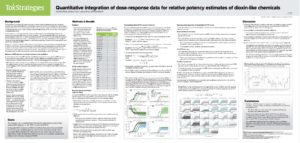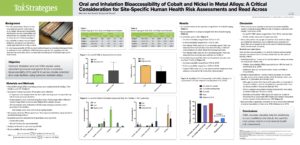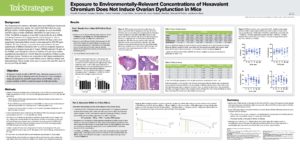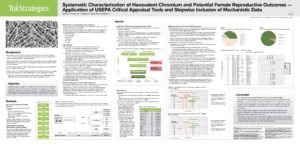The EPA has released a new web-based tool to help people identify disinfectant products best suited for their needs. The new web tool is based on information from EPA’s List N, a list of more than 400 surface disinfectant products that meet the agency’s criteria for use against SARS-CoV-2, the novel human coronavirus that causes COVID-19. Click below to utilize this new tool.
Author Archives: ToxStrategies
EPA researches activities to reduce exposure risk of SARS-CoV-2
EPA researchers are engaged in a variety of activities aimed at reducing the risk of exposure to SARS-CoV-2, the virus that causes COVID-19. Their research is focused in the following areas: Cleanup and Disinfection Evaluation, Wastewater Virus Monitoring and Detection, and Salivary Antibody Assay Development. Details on these activities can be found by clicking below:
EPA releases Perchloroethylene Draft Risk Evaluation

On April 27, 2020, the U.S. Environmental Protection Agency (EPA) released the draft risk evaluation of perchloroethylene for public review and comment. Perchloroethylene is the last of the first ten chemicals to undergo risk evaluation under the amended Toxic Substances Control Act (TSCA).
USEPA solicits public comment on second set of Scope Documents for chemicals under TSCA
USEPA released the second set of Scope Documents for chemicals undergoing risk evaluation under TSCA and is soliciting public comment. Those seven chemicals include: Butyl benzyl phthalate, Dibutyl phthalate, Dicyclohexyl phthalate, Di-ethylhexyl phthalate, Di-isobutyl phthalate, Formaldehyde, Phthalic anhydride. Links to these chemicals can be found at: https://www.epa.gov/assessing-and-managing-chemicals-under-tsca/chemicals-undergoing-risk-evaluation-under-tsca.
Recent publication comparing the Threshold of Toxicological Concern (TTC) values and oral reference dose (RfD) values
ToxStrategies’ scientists have proposed potential expansions of the use cases for the threshold of toxicological concern (TTC) in human health risk assessment applications. Analyses indicate that conservative TTC values for chemicals are, on average, approximately six-fold lower than IRIS derived reference dose (RfD) values for noncancer effects. The findings have three potential applications: (1) serve as provisional toxicity values estimated from TTC Cramer Classifications in data-poor or emergency situations, (2) serve as a comparator for toxicity criteria derived by multiple agencies or stakeholders, and (3) identify RfD values that might warrant reanalysis when they are substantially lower than their corresponding TTC value. Importantly, the findings reaffirm the health protective nature of TTC values, with the majority of TTC values being lower than their corresponding RfD values.
The open-access article was published in Regulatory Toxicology and Pharmacology.
ToxStrategies SOT 2020 E-Posters
ToxStrategies scientists have the following e-posters available for viewing via the SOT Virtual Meeting Program. Please click on the poster to view abstract and full poster.
Dr. Ali Chesney, lead author on The Process and Challenges of Deriving Exposure-Based Limits for Toxicological Risk Assessment for Components and Impurities Present in Cell Therapy Products with Case Studies
Dr. Allison Franzen, lead author on An Adverse Outcome Pathway for Renal Tumors in Male Rats through Chemical induction of α2u-globulin (α2u) Nephropathy (α2u-N)
Deborah Proctor, lead author on Risk Assessment of Manganese Exposure for Pica Child: Application of PBPK Modeling
Dr. Rayetta Henderson, lead author on Creating a Literature Database for Cannabidiol (CBD): Systematic Evidence Mapping
Dr. Caroline Ring, lead author on Quantitative integration of dose-response data for relative potency estimates of dioxin-like chemicals
Mina Suh, lead author on Oral and Inhalation Bioaccessibility of Cobalt and Nickel in Metal Alloys: A Critical Consideration for Site-Specific Human Health Risk Assessments and Read Across
Dr. Chad Thompson, lead author on Exposure to Environmentally Relevant Concentrations of Hexavalent Chromium Do Not Induce Ovarian Dysfunction in Mice
Dr. Daniele Wikoff, lead author on Systematic Characterization of Hexavalent Chromium and Potential Female Reproductive Outcomes – Application of USEPA Critical Appraisal Tools and Stepwise Inclusion of Mechanistic Data
Please follow us on Twitter and LinkedIn for our upcoming featured poster of the week.
SOT to host LIVE webinars in lieu of 2020 Annual Meeting

Over the next several months, the Society of Toxicology will host live webinars of sessions and courses originally scheduled for the 2020 SOT Annual Meeting.
Information on confirmed webinars and registration details can be found here.
TCEQ’s 2020 Environmental Trade Fair & Conference has been canceled
Due to concerns over COVID-19 (Coronavirus), the Texas Commission on Environmental Quality has canceled the 2020 Environmental Trade Fair & Conference.
Next’s years Trade Fair & Conference is tentatively scheduled for May 11-12, 2021.

